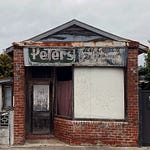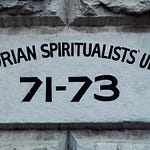In 2022, amid the clang of jackhammers, brunch orders, and gentrification, the wall of a soon-to-be boutique hotel split open and out came the ghost of a 1904 grifter.
DR. MORSE’S INDIAN ROOT PILLS — THE FAMILY MEDICINE.

Painted in defiant indigo, the sign hadn’t seen daylight in 115 years. But there it was — bold as brass, peddling the miracle cure of an imaginary frontier doctor who was about as real as a health insurance CEO with a conscience, promising salvation for your liver, your headaches, your digestion, your aching spleen, your general sense of dread, and quite possibly, your immortal soul.
This was not modern medicine. This was 19th-century snake oil theatre — a time when anyone with a moustache and a printing press could bottle some backyard weeds, slap on a label, and sell it as medicinal salvation.
“Dr. Morse,” according to the marketing, was a rugged healer who wandered the American wilderness and learned the secrets of Native tribes. Which is marketing-speak for: he was invented by a white guy with a marketing problem and zero formal education.
The real wizard behind the curtain was A. B. Comstock — carnival barker, publishing baron, and spiritual father to every late-night infomercial ever broadcast. He turned an herbal laxative into a global phenomenon using almanacs, comic books, and enough outrageous storytelling to fill a Pentecostal revival tent.
His almanacs didn’t just advertise — they evangelised. They told stories of dying fathers revived, crippled children skipping rope, dogs resurrected, crops restored, and devils banished — all thanks to a daily dose of Dr. Morse’s Pills. Side effects included blindness, bloating, and spontaneous devotion to the good doctor’s miracle pills.
And Australians? We loved it. From the bush to the beachside chemist, we were downing these pills like VB at a footy match. The slogan should’ve been: “Your bowels need Jesus — and Dr. Morse.”
By the early 20th century, the whole operation had gone global. The pills were churned out in New York and flung across the British Empire like confetti — packed into little glass bottles and marketed as blood purifiers, indigestion slayers, and moral restoratives. No evidence required. No regulation in sight. Just vibes.
But eventually, science crashed the party.
Penicillin arrived. X-rays happened. Regulators kicked in the door. And suddenly, pills that claimed to cure everything short of demonic possession were less “miracle” and more “liability.”
So Dr. Morse slipped quietly into obscurity. The signs were covered. The almanacs pulped. The great gastrointestinal revival was over.
Until one day, on Smith Street, he returned. Briefly. Gloriously. A ghost in the brickwork. A flare of old-world grift flickering in the filtered light of a thousand Instagram stories. Then, just as quickly, he was buried again — sealed behind latte-stained render and designer tiles.
Because the cure for death, as it turns out, was just another hotel.














Share this post